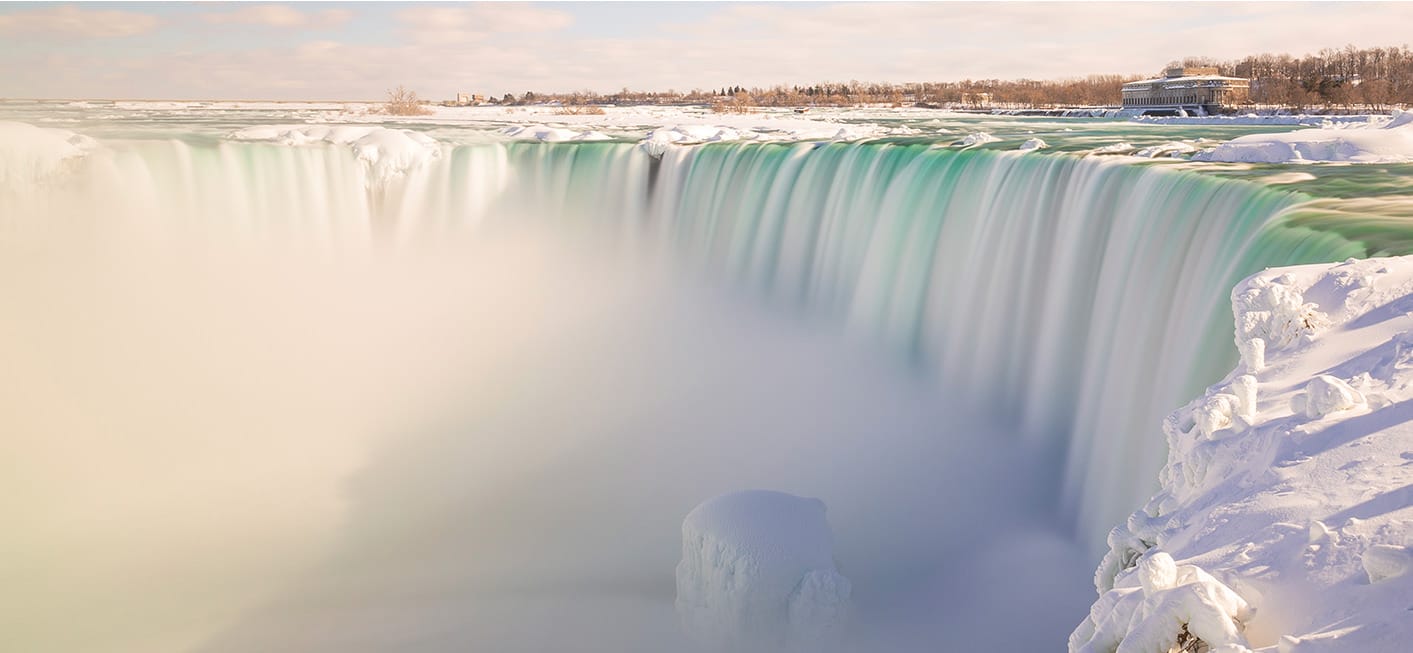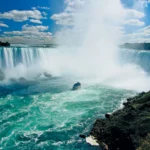Picture this: immense cascades of water thundering down, illuminating the surroundings with their rainbow-hued mist. Niagara Falls, an awe-inspiring natural wonder, might seem like a transient marvel, but hold on tight because the truth is far from it. This watery giant dances without end, and we’re about to reveal the secret behind its eternal flow!
How Does Niagara Falls Not Run Out of Water?
Ever stood at the edge of Niagara Falls, mesmerized by that crazy amount of water thundering down? It’s seriously impressive, right? But then, a thought pops into your head: how on earth does this massive waterfall not run dry? It’s a question that probably everyone asks when they see Niagara Falls for the first time!
The answer lies in the remarkable interplay of natural forces and human ingenuity.
The Great Lakes Connection
Niagara Falls isn’t an isolated wonder; it’s an integral part of a vast freshwater system – the Great Lakes. Lake Erie, situated just upstream, serves as the falls’ primary water supplier. Think of it as a massive, continuously replenished reservoir feeding the Niagara River, which acts as a giant pipeline delivering a constant flow to the falls.
If you’ve ever wondered how Niagara Falls has so much water, you’re not alone. The answer is a bit complicated, but it all starts with the Great Lakes. They collectively hold approximately 20% of the world’s freshwater, and it’s this immense volume that ensures the falls’ relentless roar.
Taming the Flow: Water Diversions and Hydroelectric Power
While nature provides the source, humans have learned to work in harmony with the falls, harnessing their power while ensuring their preservation. Water diversions, carefully engineered channels, redirect a portion of the Niagara River’s flow. This serves two crucial purposes:
- Erosion Control: By redirecting some of the water’s force, engineers can mitigate the erosive impact on the falls, helping to preserve this natural wonder.
- Hydroelectric Power Generation: The diverted water isn’t wasted – it’s used to power hydroelectric plants, generating clean energy. It’s a win-win situation, utilizing the falls’ power while protecting them.
The Enduring Bedrock: Nature’s Foundation
Niagara Falls’ ability to withstand the constant onslaught of water is also due to the geological makeup of its base. The falls sit atop a sturdy layer of limestone, a type of rock known for its slow erosion rate. This natural armor helps the falls maintain their form and resist the erosive power of the water.
A Symphony of Natural and Human Forces
In essence, Niagara Falls’ enduring flow is a testament to the delicate balance between natural processes and human intervention. The Great Lakes provide the source, engineered diversions help manage the flow and generate power, and the resilient bedrock provides a steadfast foundation. It’s a remarkable example of how we can work with nature to preserve its wonders.
How do they stop the water going over Niagara Falls?
The sheer power and volume of water cascading over Niagara Falls are mesmerizing. Yet, surprisingly, there are times when the amount of water flowing over the falls is intentionally reduced. This isn’t about permanently shutting off the falls but rather a testament to the careful management required to preserve this natural wonder.
Harnessing the Power: Hydroelectric Generation
One reason for reducing water flow is to generate hydroelectric power. Niagara Falls isn’t just a pretty face; it’s a major source of clean energy for both the United States and Canada. To harness this power, some of the water is diverted away from the falls, primarily during nighttime hours, to power turbines in hydroelectric plants.
Taming the Ice: Ice Booms to the Rescue
Another reason for controlling water flow relates to ice management, especially during the colder months. Engineers utilize a fascinating technology called an “ice boom”—a large barrier strategically placed in the Niagara River upstream from the falls. This boom helps control ice formation, preventing large chunks from forming and potentially damaging the falls’ structure.
The Time They Turned Off the American Falls: A Moment in History
Perhaps the most dramatic example of controlling Niagara Falls’ water flow occurred in 1969. The American Falls, one side of the majestic cascade, was experiencing significant erosion. Engineers, concerned about its stability, embarked on an audacious plan.
They constructed a massive temporary dam, known as a “cofferdam,” using tons of rock. This effectively redirected the entire flow of the Niagara River away from the American Falls and over to the Horseshoe Falls. For several months, the American Falls stood dry, a sight that captivated the world.
This pause in the flow allowed engineers and geologists to study the exposed rock face, assess the erosion damage, and make necessary repairs. It was a monumental undertaking that underscored the importance of proactive measures to ensure the falls’ long-term survival.
Balancing Power and Preservation
The efforts to control Niagara Falls’ water flow highlight the delicate balance between harnessing its power and ensuring its preservation. It’s a testament to human ingenuity working in concert with nature to sustain one of the world’s most awe-inspiring natural wonders.
How does Niagara Falls have so much water?
Niagara Falls’ relentless deluge of water is a sight to behold, leaving many to ponder the source of its seemingly inexhaustible supply. The answer lies in a fascinating combination of geography, geology, and the sheer scale of the Great Lakes system.
The Great Lakes: A Natural Reservoir
Imagine a chain of enormous bathtubs, constantly overflowing into one another—that’s the essence of the Great Lakes. These five interconnected freshwater lakes—Superior, Michigan, Huron, Erie, and Ontario—form a system that holds an astounding one-fifth of the world’s total surface freshwater.
Among these, Lake Erie plays a pivotal role as the primary source for Niagara Falls. This massive lake, the fourth largest of the Great Lakes, acts like a giant faucet, continuously feeding the Niagara River.
The Niagara River: A Watery Conveyor Belt
The Niagara River serves as the conduit between Lake Erie and Niagara Falls. It carries the lake’s bounty northward, channeling an average of 685,000 gallons of water over the falls every second. That’s enough to fill five Olympic-sized swimming pools in the blink of an eye!
Erosion: Shaping the Falls and Maintaining Flow
While it might seem counterintuitive, erosion—the gradual wearing away of rock—is essential in maintaining Niagara Falls’ impressive flow. The falls themselves are not static structures but rather dynamic formations shaped by the relentless force of water over millennia.
Beneath the falls lies a layer of softer rock called shale, topped by a harder layer of dolomite. As water cascades over the falls, it erodes the softer shale at a faster rate. This creates an “undercut,” where the lower portion of the falls erodes more quickly than the top. Eventually, the harder dolomite above loses support and collapses, adding more rock and debris to the base of the falls.
This continuous cycle of erosion ensures that Niagara Falls maintains its dramatic vertical drop, contributing to its awe-inspiring grandeur.
A Symphony of Natural Processes
Niagara Falls’ abundant water supply is a testament to the intricate interplay of natural processes. The vast reserves of the Great Lakes, the channeling power of the Niagara River, and the ongoing geological dance of erosion all work in concert to create this mesmerizing spectacle.
How do they control water flow over Niagara Falls?
Niagara Falls might appear to be an untamable force of nature, but humans have developed ingenious methods to manage its water flow, striking a balance between harnessing its power and preserving its beauty.
Diverting the Flow: Tunnels, Canals, and Power Plants
One of the primary ways engineers regulate Niagara Falls’ water flow is through a system of diversions. These include:
- Tunnels: Three massive tunnels, built deep beneath the city of Niagara Falls, divert water from the Niagara River before it reaches the falls.
- Open-Cut Canal: An open-cut canal, constructed in the early 20th century, further enhances water diversion capabilities.
The diverted water is channeled to the Sir Adam Beck Generating Plants, situated a few miles downstream from the falls. These hydroelectric power plants utilize the diverted water to generate millions of kilowatts of clean energy, powering homes and businesses in both the United States and Canada.
Nighttime Reductions for Maintenance and Power Generation
To minimize the visual impact of reduced water flow, most diversions occur during the nighttime hours. Between 9 p.m. and 8 a.m., the amount of water flowing over Niagara Falls is often reduced by as much as 50%. This strategic timing allows for essential maintenance and repairs on the hydroelectric infrastructure while most tourists are asleep.
A Balancing Act: Power, Preservation, and the Environment
Controlling Niagara Falls’ water flow is a complex balancing act. While hydroelectric power generation provides a valuable source of clean energy, it also necessitates diverting water away from the falls, potentially impacting their aesthetic appeal and the surrounding ecosystem.
Ongoing research and monitoring help ensure that water management practices strike a sustainable balance between human needs and the long-term health of this natural wonder.
How Many Times Has Niagara Falls Stopped Flowing?
Niagara Falls, with its relentless torrent of water, evokes an image of unstoppable natural force. It might seem unfathomable that such a powerful entity could ever come to a standstill. Yet, in the recorded history of the falls, there has been one extraordinary instance where the mighty Niagara was silenced.
The Great Ice Jam of 1848
On March 29, 1848, an extraordinary event unfolded on the Niagara River—a massive ice jam. A strong southwest wind drove vast quantities of ice from Lake Erie into the mouth of the river. The ice accumulated with such force and volume that it created an impenetrable dam, effectively blocking the flow of water to Niagara Falls.
For approximately 30 hours, the falls ran dry. The American Falls, starved of its usual watery curtain, revealed its rocky underbelly. The Horseshoe Falls, while still receiving a trickle of water from the upper Niagara River, was reduced to a mere whisper of its former glory.
A Sight to Behold
The silencing of Niagara Falls drew crowds from both Canada and the United States. People were astonished by the sight of the normally thunderous falls transformed into a frozen spectacle. It was a stark reminder of nature’s raw power and its ability to surprise even the most seasoned observers.
Preventing Future Ice Jams
The ice jam of 1848 served as a wake-up call. Engineers recognized the need for proactive measures to prevent similar events from occurring in the future. Their solution: ice booms.
These long, floating barriers, strategically placed in the Niagara River upstream from the falls, are designed to break up large ice formations and prevent them from blocking the river’s flow. The implementation of ice booms has proven largely successful, with no repeat of the 1848 ice jam.
A Moment Frozen in Time
The single recorded instance of Niagara Falls ceasing to flow serves as a captivating reminder that even the most seemingly indomitable forces of nature can be stilled. It’s a testament to the power of natural events to shape landscapes and captivate the human imagination. While we marvel at the falls’ ceaseless roar today, the story of the great ice jam of 1848 offers a glimpse into a time when the mighty Niagara was momentarily silenced.
- Discover Long Black Pepper: Flavor & Health Benefits - April 25, 2025
- Shocking Twists: The Grownup Review: Unreliable Narration - April 25, 2025
- A Quiet Place Book vs Movie: A Deep Dive - April 25, 2025
















